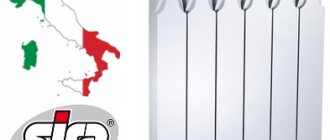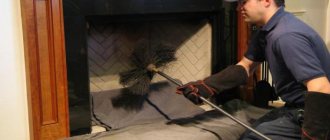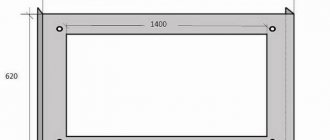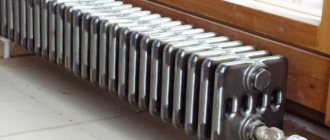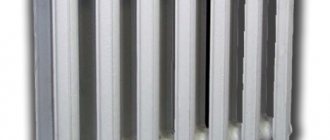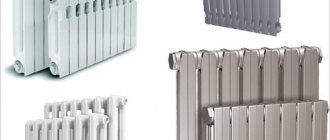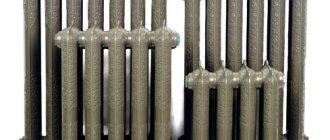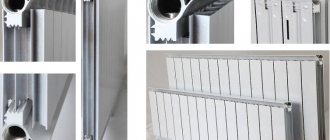Selection recommendations
And it seems to me that aluminum and bimetallic heating radiators will gradually replace cast-iron radiators. They began to be used not so long ago, so there is still a wary attitude towards them. But they have already proven themselves well and more and more people prefer them. I installed aluminum radiators in my apartment 3 years ago. They look very beautiful, no need to paint and the house has become warmer.
Considering that in the old days there was no particular choice among radiators (as a rule, most had classic cast-iron radiators), then at present there is a wide range of products on the radiator market. In my case, when choosing a radiator, there was "where to turn around", since the heating system is closed and created in my own house
On the advice of familiar installers, I drew attention to bimetallic radiators and made the right decision. For several years I have not bothered with the painting process, as is the case with cast iron, radiators do an excellent job with their functions and the house is always cozy and comfortable, regardless of the outside temperature
The only thing that had to be done additionally to protect the radiators from deposits was to install a system for deeper cleaning of the coolant.
I would not be at home and I do not advise anyone to install an aluminum or bimetallic radiator in their apartment. Bimetal in those regions where there are serious problems with water treatment - such a battery will have to be changed after one heating season. Aluminum and bimetal are assembled by hand by a craftsman and the quality of assembly depends on the professionalism of the person. Steel, for example, is assembled in fully robotic factories. Austrian radiators, among other things, have insurance against damage for 1 million and a guarantee for the entire device, and not a section like bimetal and aluminum happens. With its help, you can block the entire window opening, providing an even flow of heated air to the window. This eliminates the formation of cold air currents on frosty days.
I completely agree with you, Sergey. Bimetal and aluminum in an apartment is a risky undertaking, it is not possible to avoid contact of the coolant with the metal and there is a threat of explosion. The quality of a steel radiator is much easier to determine, here are the signs of a quality device: the uniformity of welds, gaps, painting and the availability of guarantees, insurance. And do not be lazy to consult with your master or HOA!
Bimetal has higher operating pressure characteristics - they can be safely installed in high-rise buildings (in them, the pressure usually does not exceed 6 atm). The working pressure of bimetallic radiators is 10 atm, and some can withstand 16 atm in general. It is advisable to take a little promoted brand - the plant always does the first order well.
From the section of the article on steel radiators: "Steel radiators do not withstand water hammer and pressure increased to 25 atmospheres, so it is better not to use them in heating systems of city apartments." From the section of the article on bimetallic radiators: “It turns out that the bimetallic radiator has combined the best properties of steel and aluminum heating devices. From the steel he took. resistance to pressure drops (withstands up to 40-50 atmospheres) ". Where is the truth?
The steel radiator according to the "German" technology has served a little more than 10 years. At one point, a needle-thick trickle appeared at the spot welded. For a battery, this is not a period.Soviet cast-iron batteries last half a century or longer. Now I am racking my head which one to buy. The quality of modern technology is deliberately damaged. You buy a pig in a poke.
Aluminum radiators
Aluminum radiators are one of the best metal batteries today, thanks to their high heat transfer rates, beautiful appearance and low weight. This type of device is produced in two ways: by casting and extrusion.
In the first option, a single block is created without intermediate connections, so the device is reliable. In the second case, individual elements are formed from the aluminum profile, which are then connected into a section by welding. Additional gaskets and seals increase the tightness. If the production process was carried out without violations, the welded device is not inferior in reliability to a monolithic one, however, cast radiators are still more practical. The advantages of the extrusion method include great variability: the buyer has the opportunity to arrange sections and choose the desired size. This is especially important when it is necessary to obtain a radiator of non-standard length.
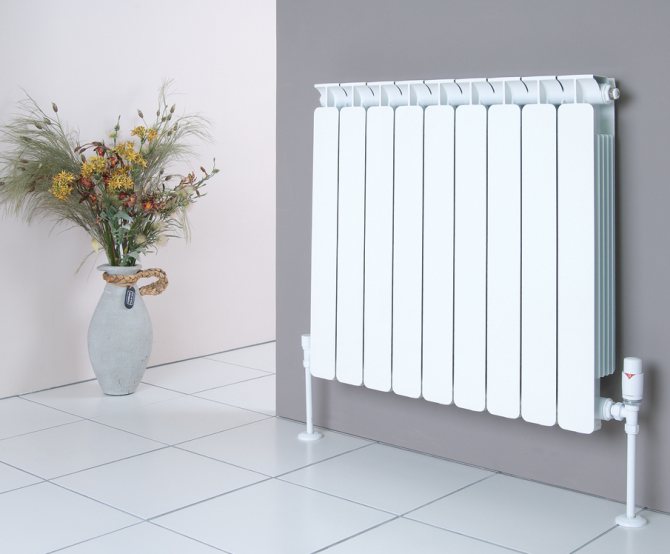
When choosing which heating battery is better, you should pay attention to the advantages of aluminum. This metal heats up quickly and also quickly gives off heat, therefore, it saves up to 35% fuel compared to other types of radiators. Already after 10-15 minutes after turning on the heating, the set temperature is set in the room. The minimalistic design makes the batteries almost invisible, so the heating system does not spoil the interior. Aluminum structures fit equally easily into the decor of an office, apartment or private house. Radiators are compact in size and light in weight, so the installation of radiators is possible on any walls.
The disadvantages are typical mainly for welded devices. Rubber seals have a shorter lifespan than metal, so they quickly deteriorate and batteries begin to leak. For the same reason, it is forbidden to add antifreeze and other chemicals to the water.
Pressure drops can also destroy welds, which is why only cast solid blocks can be used in district heating systems. In addition, water contaminated with hard abrasive particles over time erases a thin protective layer on the inner surface of the metal and a corrosion process begins in the batteries. In this case, the service life of the aluminum is reduced.
Radiator compatibility with heating system
The modern assortment of batteries is diverse - cast iron, aluminum, steel, copper, bimetallic devices - it is only important to understand which heating radiators will best "fit" into the specific heating system of your home. What does this mean? This means how much the technical parameters of the heater - the permissible temperature of the coolant, its pressure and composition, as well as heat transfer and inertness correspond to the indicators of your heating system
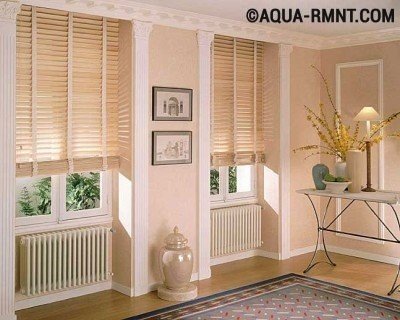

A heating radiator not only heats the room, but also carries an aesthetic load in the interior design
When buying a radiator, its appearance, durability, and, of course, the price are also important. It should be borne in mind that there are nuances in the selection of heating batteries for open systems (apartment buildings) and closed systems (individual houses). If the indicators declared by the manufacturer do not correspond to the characteristics of your heating system, then rapid wear and even failure are possible.
Technical specifications
Paying attention first of all to the appearance and cost of the radiator, nevertheless, do not forget that the technical and operational characteristics of the device should be in the foreground.Not every heating battery, both imported and domestic, will withstand the working conditions in existing domestic heating networks.
The centralized heating system, inherited from the Soviet Union, is characterized by fluctuations in pressure and temperature, as well as poor quality of the coolant (water). The design temperature for a single-pipe open domestic system in high-rise buildings is 105 degrees Celsius, the pressure is 10 atmospheres. However, these parameters sometimes go off scale when starting the heating system after the summer period, which leads to water hammer, which some heating devices from foreign manufacturers are not designed for.
Not every heating battery, both imported and domestic, will withstand the working conditions in existing domestic heating networks. The centralized heating system, inherited from the Soviet Union, is characterized by fluctuations in pressure and temperature, as well as poor quality of the coolant (water). The design temperature for a single-pipe open domestic system in high-rise buildings is 105 degrees Celsius, the pressure is 10 atmospheres. However, these parameters sometimes go off scale when starting the heating system after the summer period, which leads to water hammer, which some heating devices from foreign manufacturers are not designed for.
It is imperative to pay attention to the permissible temperature and pressure of the coolant in the heating system, which are indicated in the passport of the heater. Anodized aluminum panel radiators allow operation in pressurized systems and do not require paintwork
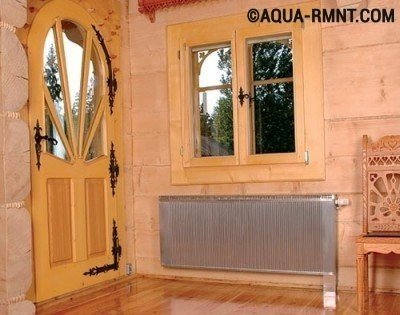

Anodized aluminum panel radiators allow operation in pressurized systems and do not require paintwork
Another fundamental parameter for a heating battery is its heat transfer. This characteristic affects the efficiency of heating the air in the room and depends on the material incorporated in the structure. It is well known that the heat transfer of steel is lower than that of aluminum, and copper is better than cast iron in this indicator. But, based on any one technical parameter, it will not be entirely correct. It is necessary to comprehensively evaluate all the pros and cons of each type of heating device in order to opt for the best option.
Ways to connect panel radiators
Narrow heating radiators can be installed in circuits with bottom and side connections. The design of the device is selected depending on the connection used. The side connection to the wiring can be mounted on the right or left side of the unit. The connection itself is straightforward.
Heating batteries with bottom connection are considered universal, since they have a thermostatic regulator. This device allows you to adjust the room temperature. Another plus of the bottom connection is that the wiring pipes can be hidden in the wall or floor structure.
On a note! Devices that have a bottom connection are marked with the letter "V". They are more expensive than side discharge units.
You can find imported and domestic panel batteries on sale. The most popular are European and Turkish models. Moreover, Turkish units are 30% cheaper than European ones. When choosing a suitable heater, it is important to carefully study the technical documentation, as well as take into account the reviews about a particular manufacturer.
What are flat heating radiators
It is necessary to start talking about flat heating batteries with their depth size. There is no exact indicator that would indicate the fineness of the device.This is mostly determined by eye. For example, a cast-iron radiator can be taken as a standard - this is a common design. Anything that will be less than half its depth, and can be attributed to flat heating radiators.
If you make an overview of all existing models, then only steel panel batteries are suitable for this standard. We will consider them. Why is it that panel structures are thin? It's all about the technology of their manufacture.
How can you flush the heating battery
These are devices made from stamped steel sheets. The form is based on a solid sheet with a sufficiently large embedment area. That is, it is not a sectional structure, but flat over the entire area of the heater itself. This is precisely what is achieved by increasing the heat output. But at the same time, the depth of each panel is not very large, and accordingly the volume of the coolant used in the heating system in the flattest radiator will be small. This ratio has a definite plus - a low fuel consumption for heating the coolant. That is, these two values are in direct proportion.
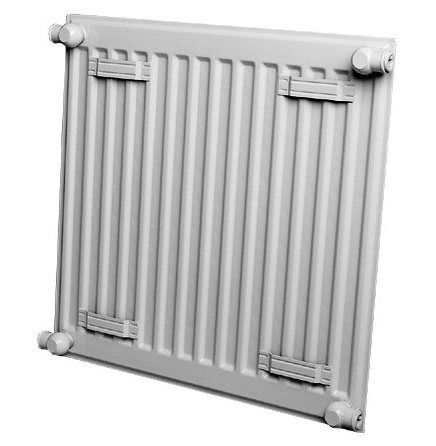

Manufacturers have gone further. They did not get hung up on devices with a purely panel form, because, as mentioned above, this form has a reduced power. To increase this indicator, additions were made to the structure itself in the form of a finning system, the so-called convection ribs. They are welded over the entire area of the battery by spot welding. The main shape of the ribs is trapezoidal.
Types of flat radiators
The classification of flat radiators is the same for all manufacturers. There are five types in total: 10, 11, 12, 22 and 33. How do they differ from each other?
- Type 10 is just a no-nonsense stamped panel. If we talk about the category "thinnest heating radiators", then this type is the basis of this category. You will not find it thinner on the market. Let's take a look at the type on the example of Kermi radiators. So type 10 has a depth of 46 mm.
- Type 11 is one panel with one layer of finning system. The depth of this model is 59 mm. Quiet and it can be classified as "flat".
- Type 12 consists of two panels with convection ribs installed between them. Its thickness is 64 mm.
- Type 22 is a structure consisting of two panels and two finning systems, which are located between the panel planes. Depth - 102 mm.
- Type 33 consists of three panels. Between the first two, two layers of ribs are installed, between the second and the third one layer. Depth 157 mm.
For other manufacturers, the depth size can vary in the same range with small deviations in one direction or another. The deviations are insignificant, so the dimensions of Kermi heating radiators can be taken as the basis for our analysis.
Attention! All types of steel panel radiators, except for type 10, are equipped with protective side walls and an upper grill. This improves the appearance of the device, but increases its cost.
And one more thing, convection fins are a real dust collector, which is very difficult to clean.
But now let's choose from this type those heating devices that can enter the category of "flat". Let's start with the fact that the depth of the ChM-140 cast-iron radiator is 140 mm. We will build on this.
You can immediately determine that the first three types, which are 10, 11 and 12, are subtle. But 22 and 33 are not included in this category. That is, it turns out that not all steel panel heating radiators can be considered flat.
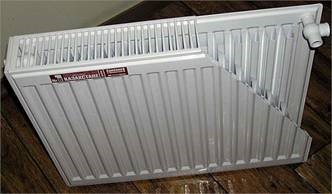

What it is
First of all, you should familiarize yourself with the positive characteristics of flat batteries:
- Thanks to the flat shape of the device, useful space in the house is saved.
- The small thickness of the battery allows the use of thinner window sills, which is used in certain interior styles.
- The smaller the surface area, the less dust and dirt collects on it.
- The flat shape makes it much easier to clean the radiator from dirt. A similar procedure on a sectional battery takes much longer.
- Outwardly, the device will be distinguished by its attractiveness and originality, resembling a beautiful white panel. This makes it possible to refuse additional decorative screens.
It is also important to find out how well a flat single row radiator heats the surrounding area. As you know, the area of the heating surface directly affects the efficiency of the device. The first impression from external inspection: due to the reduction in the area of the radiator, its heat transfer is also reduced. However, this is not at all the case: the design uses some tricks that allow the device to take a leading position in the market.
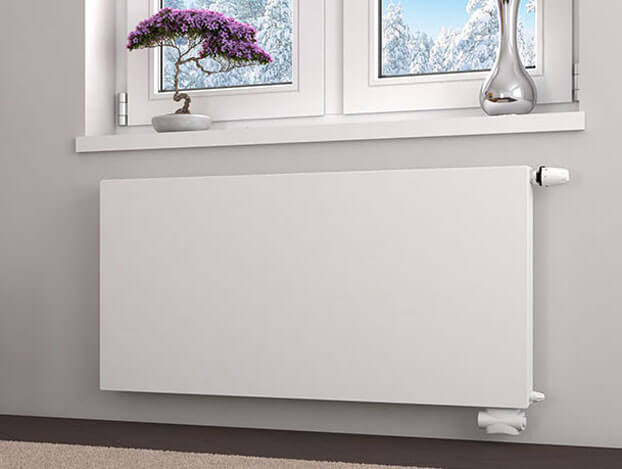

First, you should pay attention to the depth of thin heating radiators. There are no prescribed norms for this criterion: the emphasis here is on visual assessment. The reference point is usually a standard type cast iron battery. The thickness of a flat panel radiator is almost twice as thin.
Characteristics of sectional types of heating batteries and their comparison
- Cast iron sectional radiators
... Considering the types of heating batteries, it should be noted that it is cast iron devices that have been known to consumers for a long time, since the times of the Soviet Union. In those years, they were installed everywhere - in residential, industrial and public premises.
The design solution of cast-iron sectional radiators allows them to be heated to high temperatures. Due to the peculiarities of cast iron as a material for making batteries, they give off heat for a long time and therefore in those years they were assigned leading positions among heating devices, the heat transfer of cast iron radiators is quite good.
True, cast-iron radiators need to be warmed up to the desired temperature for a longer time, and this requires a larger amount of fuel or energy carrier. In order to save money, not all consumers choose cast iron products for installation.
The appearance of modern cast iron radiators has undergone minor changes with the same technical characteristics. One section is capable of heating about two "squares" of the area. You can even find designer models on sale that can decorate a room.
Since a large amount of fuel is needed to heat cast iron appliances, they are not installed if they plan to use expensive energy sources, for example, electricity. They choose more economical heating radiators, including aluminum batteries.
Aluminum sectional radiators
... These devices are considered a modern alternative to cast iron devices, since they are lighter and less heat-consuming. Aluminum sectional products give off heat no worse than cast iron and quickly warm up to the desired temperature (for more details: "How to choose aluminum radiators: technical characteristics"). Thanks to their aesthetic and neat appearance, they fit perfectly into a modern interior. One aluminum section heats one "square" of the room. If you install such batteries yourself, you can handle the installation without any problems on your own, since they are much lighter than cast iron products. According to experts, if we compare heating batteries for a private house, then the clear leaders are now aluminum sectional radiators.
Bimetallic radiators
... Outwardly, such heating batteries are similar to aluminum appliances. Sectional bimetallic heating radiators can be seen in the photo. They are joined by elements made of steel and aluminum. Due to the manufacture of two alloys, these devices are called bimetallic.
When you look at a bimetallic heating radiator in section, you can see a stainless steel heat-conducting channel inside it. Thanks to this design, the durability of the devices has increased significantly. And the thermal conductivity of bimetallic radiators is greater than that of aluminum. These heating products can be installed with an economy class coolant. One section of such a radiator supplies heat to 1.4 "squares" of the area. Bimetallic radiators are lightweight, and their installation is similar to the installation of aluminum batteries.
For different types of modern heating devices, sections may differ in size. Therefore, when choosing radiators, the section power should be specified. Based on this parameter, you can calculate the number of sections, taking into account the area of the room.
We disassemble flat heating radiators
Anyone who has visited a specialized store selling heating equipment at least once can appreciate the whole variety of heating appliances offered on the market. In fact, this is a huge assortment that allows you to make a choice according to the consumer's taste. No wonder they say that demand creates supply. So this postulate is directly related to modern heating radiators. But the topic of our article is flat radiators. Why are they called that, and why are they needed at all? We will answer these and other questions.
Let's start with the second question, which defines the purpose of the flat structure. There are several positions here:
- Reducing the size of the heater - increasing the free space of the room. This is especially true for the windowsill. With flat radiators, its width decreases dramatically. Good or bad, everyone decides for himself, but the designers are delighted with it. There is an opportunity to experiment.
- The heating battery itself is a kind of dust collection. By reducing the width of the device, we reduce the plane on which the dust settles.
- Let's add that flat batteries have a presentable appearance. In any case, they differ significantly from the sectional models.
And now the most important question related to the heat transfer of this type of radiators. How much is this indicator decreasing? It's no secret that the size of the heating battery affects the amount of heat output. To thoroughly understand this issue, you need to understand what flat heating devices are.
Installation
Flat radiators are most suitable for rooms with a closed heating system. The presence of an expansion tank is a prerequisite.
The heating process consists of the following steps:
- The pump acts on the coolant, which, in turn, begins to circulate through the pipeline.
- Then it goes through the valve.
- At the next stage, it ends up in the radiator.
- Then he moves along the air carrier.
- It moves to the return pipe until it reaches the expansion tank with a membrane.
If you decide to install flat radiators for an open heating system, then remember that in this case they will not last long, because will not be able to withstand corrosive processes.
Do not purchase thin radiators for installation in rooms with high humidity.
Overview of flat products
Features of production
If we are talking about flat models, then most often we mean not the surface relief, but the depth of the radiator. In this case, the term "flat" can be interpreted in different ways, because this category very often includes all batteries, the depth of which is less than that of a standard cast iron product.
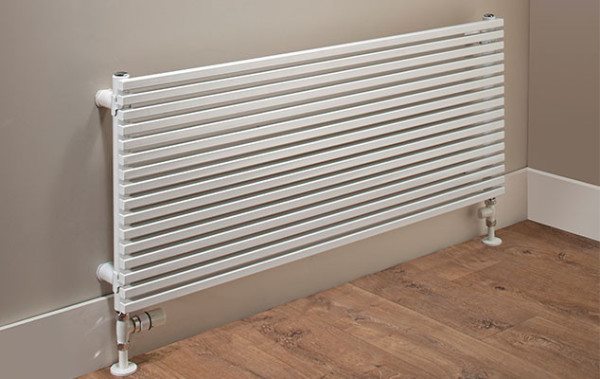

Shallow depth aluminum products
Almost all devices of this type are steel panel heaters.No, in principle, you can find both a flat oil cooler and an aluminum structure, but the main niche in this market segment is occupied by steel.
The following mixed technology radiators are produced:
- The basis of the product is a stamped steel sheet, which is machined and forms the inner contour of the heater.
- Due to stamping, a profile is formed, which provides an increase in the heat transfer area.
- Trapezoidal convection fins are sometimes welded to the main sheet to increase efficiency. As it passes through the fins, the air is heated and then distributed throughout the room. (See also the article Repairing heating pipes: features.)
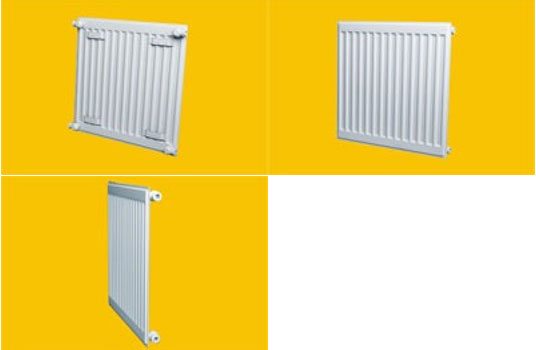

Appearance of a flat panel model
As a result of all these operations, a flat steel radiator is obtained, which combines compact dimensions with a fairly good heat transfer. Of course, in this parameter it will be inferior to full-size models, however, if it is the shape that is important to us, then we will have to put up with some heat losses.
Types of panel radiators
Most panel radiator manufacturers use the same product classification. Once you understand it, you will be able to determine the depth of the model and its structure at a glance - even if you are not in front of the battery itself, but only the instructions with markings.
Note! Typically, the first number indicates the number of panels, the second the number of rows of convection fins.
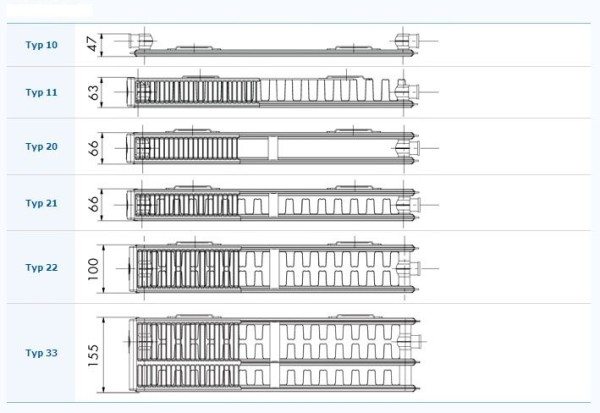

Design features of different types
How the legend is deciphered, we will tell in the table below:
Main varieties
Flat heaters are easy to distinguish from traditional sectional counterparts in appearance. The front side of the devices is a solid panel, sometimes smooth, more often a corrugated panel with or without perforation.
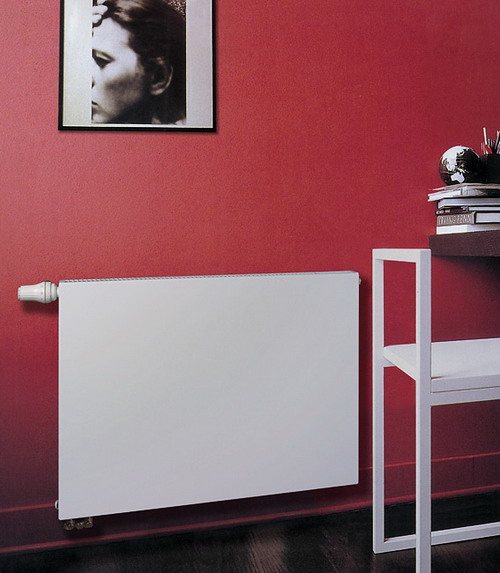

Smooth surface model
Conventionally, all heating devices belonging to the flat category can be subdivided into the following types:
- wall panel batteries with heated water as a heat carrier;
- oil-fired electric heaters with the possibility of mounting on a wall or with a floor arrangement;
- electric convectors with wall and floor arrangement.
All these heating devices, despite the obvious differences, are characterized by a small thickness, which greatly simplifies their installation on the wall. Consider the features of the device and operation of each of the listed modifications.
Panel batteries
The photo shows an example of a compact installation of a flat heater
This category of equipment, first of all, should include a flat steel radiator, which today can be purchased in most specialized stores.
Outwardly, such devices are a rectangular plate, in the upper part of which there is a perforation necessary for the release of heated air. Metal tubes with radiator fins are located inside the casing.
Due to the circulation of the coolant through the tubes, warm air is partially released, passing through the upper perforation, and partially heats the front metal surface, which, in turn, also releases heat into the room.
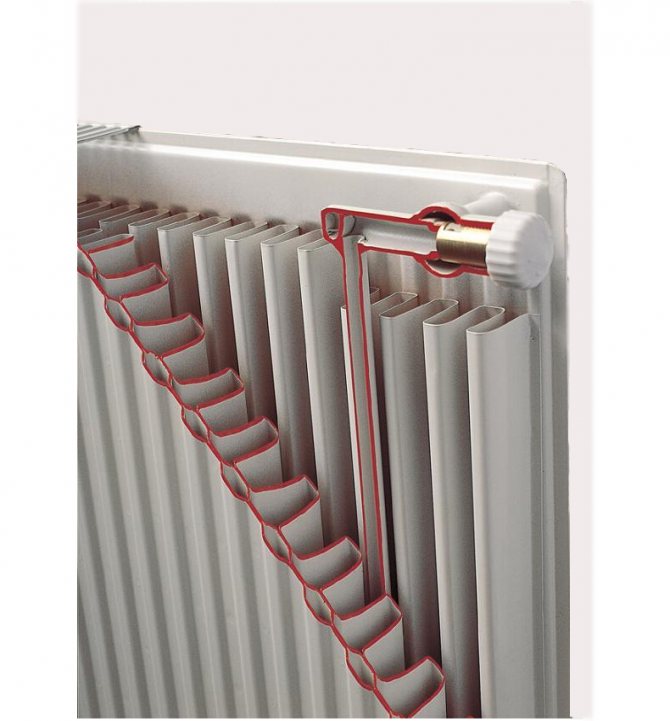

Sectional steel flat heating radiator
The steel panel radiator is mainly intended for installation in autonomous heating systems and is not recommended for use in centralized systems.
The fact is that the device is designed to operate with a low pressure of the coolant, no more than 10 atmospheres at a temperature of no more than + 100 ° C. Nevertheless, the statistics of the operation of panel steel batteries show that such devices are successfully operated in apartment buildings.
Important: A serious threat to steel batteries is the specific composition of the coolant in the centralized heating system.The presence of reagents in the circulating water can accelerate the course of corrosive processes.
Oil fired electric heaters
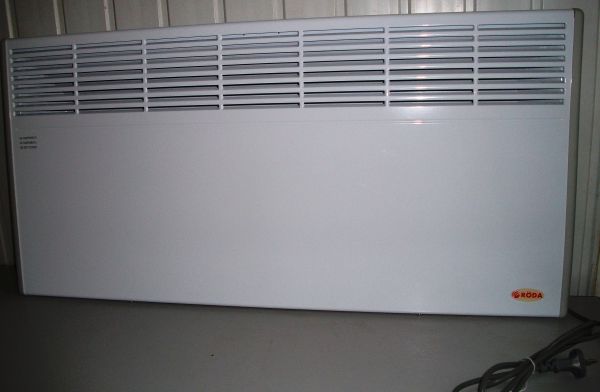

Flat oil cooler, wall-mounted and floor-mounted
There are two types of oil heaters on the market: sectional and panel heaters. We are interested in a flat panel version with the possibility of wall or floor installation.
This heater differs from other batteries in that not water, but mineral oil is used as a heat carrier. This solution has the characteristic advantage that oil, in comparison with water, cools down longer and, as a result, releases heat longer.
Oil panel radiators have the following advantages:
- Low energy consumption compared to spiral electric heaters.
- Does not dry the air and, as a result, comfortable living conditions in the room.
- Low temperature of the heated surface and, as a result, there is no danger of getting burned with careless touch.
- A wide range of heaters on sale and, as a result, the ability to choose a device with suitable dimensions.
- Affordable price.
- Relatively low weight and, as a result, the ability to mount on any walls.
- Simple installation instructions, and therefore it is possible to do the installation yourself.
Important: Due to their independence from heating systems, such heaters can be installed not only in apartments used for permanent residence, but also in seasonal suburban houses.
Wall mounted electric convector
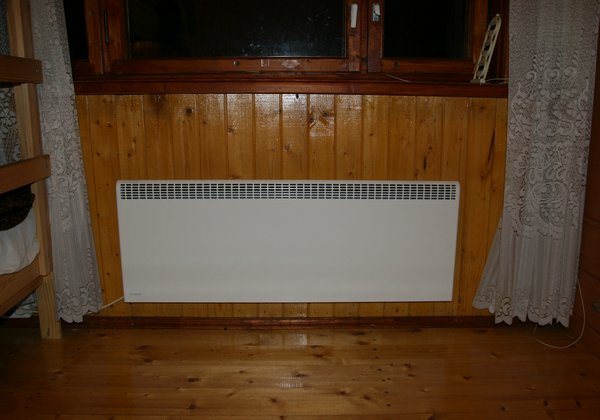

Electric convector in the interior of the cottage
When listing flat thin heating radiators, one cannot fail to note electric heating convectors. These devices are also available for sale in a wide range of modifications, which are distinguished by price, standard sizes, power consumption, design of heating elements, etc.
Unlike a traditional radiator, in which one or another coolant circulates, this device uses heating elements that transfer heat to metal plates, which, in turn, release this heat through slots in the upper part of the protective casing.
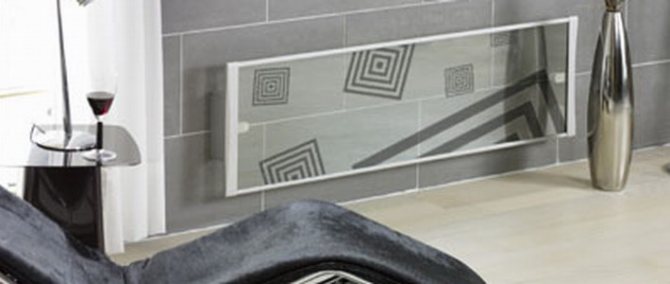

Electric convector in the interior of a modern apartment
In the process of air convection, the device can quickly warm up the room. This category of heating devices is universal in terms of operation, but, nevertheless, it is the best choice for cottages, in which residence is of an episodic nature.
So, we have decided on the main types of flat heating devices that can be used in an apartment or a country house. In conclusion, we will consider in more detail the features of the selection of panel heating radiators in relation to a particular living space.
Features of the selection of steel panel batteries
When choosing steel radiators, you should pay attention to the marking.
The following letter designations can be found in the marking:
- kv - lower connection type;
- k - lateral connection type.
In addition to letter designations, there are numerical values in the marking:
- 11 - type of batteries with one external heating surface.
- 21 - type with two heating panels and one heat exchanger through which the heat carrier circulates.
- 22 is a type with two panels and two heat exchangers between them.
- 33 is a type with three panels and three heat exchangers.
So, we have decided on the marking, but which one to choose?
For use in standard-layout apartments, the twenty-first type of radiator will be the best choice. This choice is explained by the small thickness, acceptable heat transfer and low cost.
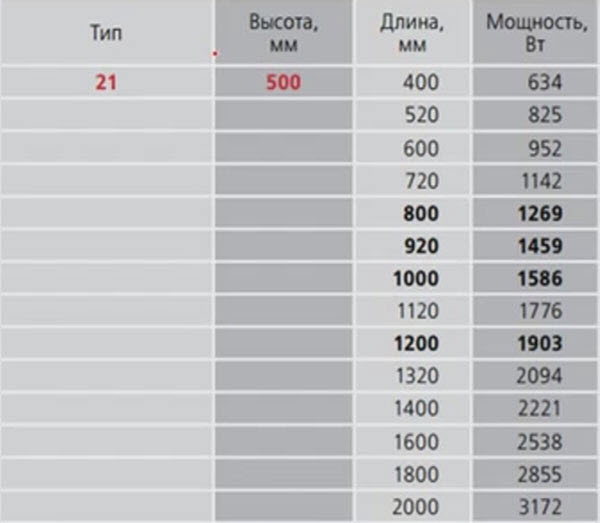

The ratio of the height and length of panel radiators of 21 types with power parameters
Let's try to calculate the heat dissipation of a device 1 m long.
As we can see in the table, this parameter is approximately 1.5 kW. At the same time, you need to understand that this value is possible only if the coolant is heated to + 90 ° C.
In fact, the temperature of the coolant in a centralized system is much lower, and therefore the real heat transfer will be 1.5 kW not indicated in the table, and not more than 1 kW. Thus, if for normal heating of the room there is enough battery power of 1.5 kW, we do not limit ourselves to the installation of one radiator, in the passport of which the power we need is spelled out.
In order not to freeze in winter, it is better to install not one but two such radiators. Or, if the configuration of the room allows, we install a single panel 1600 mm long and this will be enough to create comfortable climatic conditions.
Popular types of heating batteries
If we compare heating radiators, then first of all it is clear that they all differ in design. Based on the fact that they look differently, batteries are divided into sectional and panel products.
Sectional radiators. Such devices are divided into three main groups:
- cast iron batteries;
- radiators made of aluminum alloy;
- bimetallic products.
From the name it is already clear that the heating device consists of sections assembled into a single structure. For example, many consumers are familiar with cast iron batteries used for more than one decade, which are a set of a specific number of sections. New aluminum appliances also consist of several sections, but if you look at these heating radiators, the comparison will be in favor of modern products, since they look more aesthetically pleasing (for more details: "Aluminum radiators - technical characteristics, installation").
Panel batteries
... They are made only of steel. Outwardly, they are a flat product with bulges. Flat batteries were widely used in the 80s of the last century. They were mainly installed in panel houses. Modern panel radiators have been modified and their appearance has changed slightly. After that, their heat transfer increased, and they are once used for heating living quarters. Making a comparison of sectional and panel heating radiators, it can be noted that the former are widely used in heating systems and consumers respond positively to them.
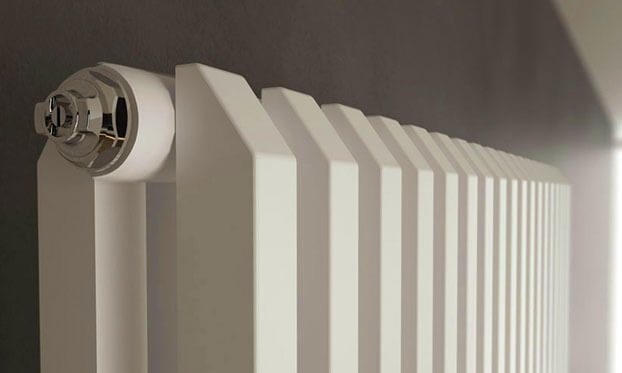

Flat panel radiator manufacturers
On the domestic market, mainly foreign products are presented - products of the companies Kermi, Zehnder and Buderus.
Kermi
Flat models are offered here in two variations - with a smooth (Plan series) or corrugated (Profil series) front surface, painted in two layers by the cataphoresis method. The side and top grilles can be removed to keep dust free. German models are available in the following varieties:
- valve modifications ThermX2. Depending on the capacity, different types of control valves are introduced;
- flat small batteries ThermX2 Kompakt are universal, they are mainly used at low temperatures;
- Hygiene line Kompakt Hygiene has a double lacquer coating, it is common in hospitals, since, due to the protective layer and simple design, it is possible to use disinfectant solutions.
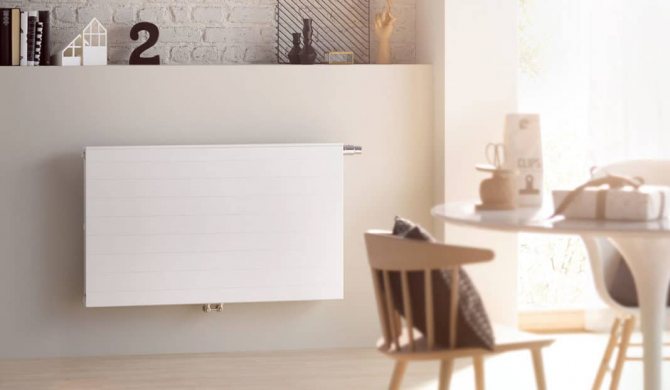

Heating batteries Kermi
The products are sold in a high price segment and exhibit efficient heat transfer.
Zehnder
The manufacturer from Germany, in addition to the classic variations, offers rulers with non-standard sizes, shapes, and raw materials. Models with printed mirrors, a front panel decorated with wood and stone, and paintings are widespread. We offer vertical and horizontal devices with angular and radius execution.
The Plano series has a discreet design, with convection blades built into the batteries. Nova Mirror - ultra-fashionable flat products with a shallow depth and a built-in mirror, ideal for narrow spaces.
What are the heating radiators
Heating batteries, they are also radiators that are installed in residential premises, are mainly water or electric.
Water types of heating batteries heat housing with water, which is used as a heat carrier (in more detail: "Water heating radiators - types and types"). After the liquid is heated to a certain temperature, it begins to circulate through pipes and batteries, giving off thermal energy to the surrounding air.
Electric heating radiators are only outwardly similar to conventional appliances, but their principle of operation is different. They are usually used as an additional source of heat, since high electricity prices make the operation of such heaters economically unprofitable.
True, if there is no opportunity to equip water heating, there is nothing else to do but to use electrical appliances for heating. Suppose that the family goes to the country house outside the city only on weekends - in this case, the electric convector will be enough, because it will not freeze.
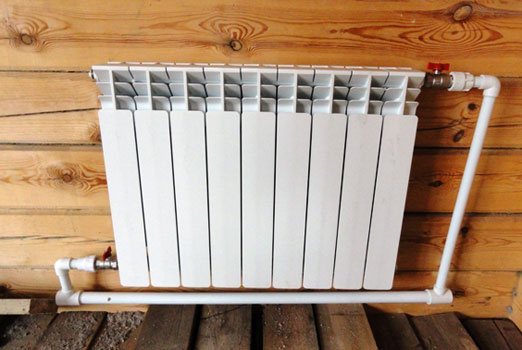

How are flat radiators made?
The manufacturing process of small panel batteries consists of the following technological steps:
- To begin with, panel blanks are stamped from sheet steel with a thickness of 1.25 mm.
- After that, U-shaped convectors are made from steel strips with a thickness of 0.3-0.5 mm. This increases the heat transfer area of the unit.
- Then the two prefabricated panels are connected to each other. Convectors are fixed on two adjacent panels.
- Installation of reinforcement elements for inserting the device into the heating system is in progress.
- Steel surfaces are powder coated.
The service life of such devices largely depends on the quality of the surface painting. High-quality powder coating reliably protects the metal from corrosion. This is especially important for radiators operating in high humidity conditions.
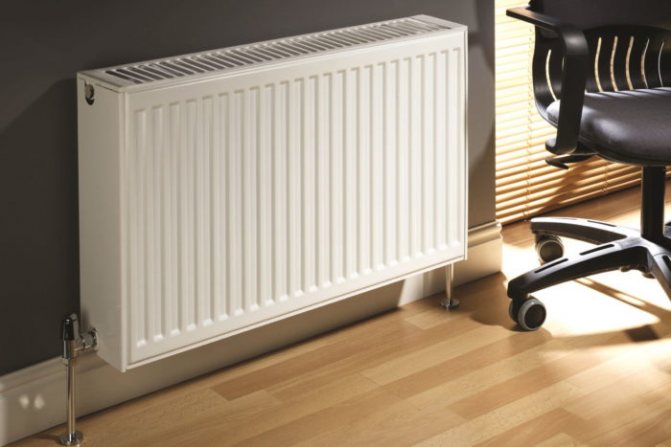

Types of electric heating radiators
Instrument painting is performed in several ways:
- by immersion in the dye composition (the technology is called OP);
- the technique of anodic electrophoresis can also be used (this method is called AEF);
- by the technology of cathodic electrophoresis (the name of the CEF method).
The KEF technology is considered the most advanced. The coating boasts reliability and durability.
Coloring using the cathodic electrophoresis technique is performed in three stages:
- The thinnest coating of zinc and manganese phosphates is applied to the steel surface. This layer is needed to increase the corrosion resistance of the metal and extend the life of the structure.
- Then the panel is immersed in the dye mixture. Moreover, the container with the coloring composition is connected to the cathode (positive electrode), and the painted panel is connected to the anode (negative electrode). The painting process stops only after the layer of paint is evenly distributed over the entire surface of the panel. Essentially, this layer becomes insulation.
- After that, epoxy powder is applied to the layer of the coloring composition on the surface of the panel. Then it is melted at a high temperature. The powder layer is needed to obtain a colored glossy finish. It does not yellow or fade and protects the material from scratches and abrasion.
Dyes containing formaldehyde and heavy metals are not used for dyeing the battery. The dye contains only 2 percent solvent. Due to this, even when the surface is heated to high temperatures, the paint layer does not emit harmful substances into the air.
After painting, the batteries are pressurized under a pressure of 1.3 MPa.After successfully passing the tests, the heater is guaranteed for 10-12 years.
What are the types of heating batteries review and comparison
With the onset of the heating season, many residents complain about cold batteries in the apartment. But utilities are not always to blame for the problem of poor heating. Often the reason lies in the fact that the heating radiators are clogged or have already become unusable and need to be replaced with modern types of heating batteries. Before proceeding with the reconstruction of the heating system, it does not hurt to ask what kind of heating batteries are and what advantages and disadvantages they have.
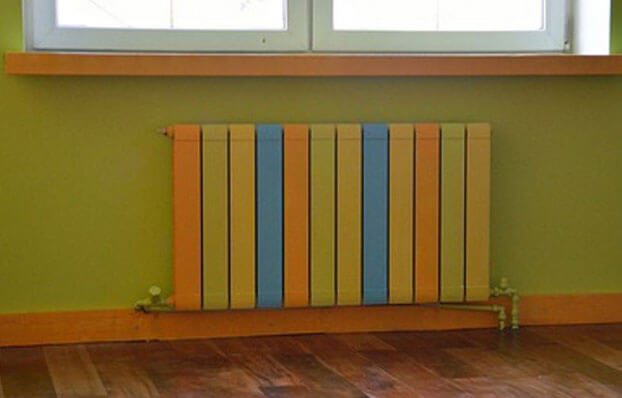

This topic is devoted to this article, which tells about modern heating devices for apartments and private households. It talks about what kind of heating radiators are.
Tubular steel radiators
When choosing which radiators are the best, buyers often look at the most inexpensive options. Tubular steel radiators belong to this category. In appearance, they are similar to traditional cast iron, but more subtle and even graceful. The structure consists of two collectors connected vertically by steel tubes, laser welded, so the seams are virtually invisible. The advantages of tubular steel include resistance to hard water, as well as ease of maintenance: due to the absence of sharp corners and difficult bends, dusting is extremely easy.
However, the product has significant drawbacks. Compared to other radiators, steel pipes are characterized by the least heat transfer, so the cost of heating increases significantly. In the area of welds, leaks form over time, so this type of product cannot be called durable. For this reason, tubular radiators are not recommended for use in apartment buildings: in the event of an accident, the damage can be enormous. Also, this system is not able to withstand pressure drops and therefore is unsuitable for modern realities.
Radiators and convectors
The types of heating devices used in the water heating system are distinguished not only by the material from which they were made, but also by the principle of operation. Since the days of the Soviet Union, radiators and convectors have been used in heating systems. Radiators have higher heat transfer rates than convectors. They radiate heat from their surface and provide constant heating of the room, and convectors move air flows from bottom to top, thus forming a draft.
Externally, convectors are also very different from radiators, just look at the photo of these devices, and you can accurately determine which device is a convector and which is a radiator.
The basis of the convector's design is the pipe through which the heat carrier passes. The pipe has thin, sharp steel plates.
The advantages of convectors include small dimensions, reliability, and low cost. These devices can be built into the floor, into the wall and placed where there is simply not enough space to install a radiator.
The disadvantages of convectors include a low heat transfer coefficient. Therefore, it is unlikely that it will be possible to warm up a large room with the help of these devices; they can only be used as additional sources of heat.
The convection method of heating a room can hardly be called an advantage. Since the convection of air, or the movement of air is simpler, this is nothing more than a draft, and you will hardly be delighted with such a phenomenon in your home. Convectors are often used in office buildings where a large glazing area makes it impossible to install conventional radiators.
What are the possible types of connection of radiators
The efficiency of the heating devices is influenced by the chosen scheme of their installation.
There are different types of connecting heating radiators:
- Diagonal connection.This method of installing heaters is suitable for long batteries that can heat up evenly. The pipe supplying the coolant is fed on one side to the branch pipe at the top, and at the bottom to the branch pipe is supplied to the branch pipe. If hot water is supplied from below, the battery efficiency will decrease by 10%.
- One-way side connection. This is the most common way to install radiators. This method of connection, in which the supply pipe is connected to the upper branch pipe, and the outlet pipe to the lower one, provides the greatest heat transfer.
- Bottom connection. This method of wiring batteries is used only if the heating system is located in the floor.
The service life of the heating system, as well as its functionality, efficiency and reliability, depend on how correctly the type of connection is chosen and how well the installation of radiators in the heating system will be made.
The area of use of flat panel heating radiators
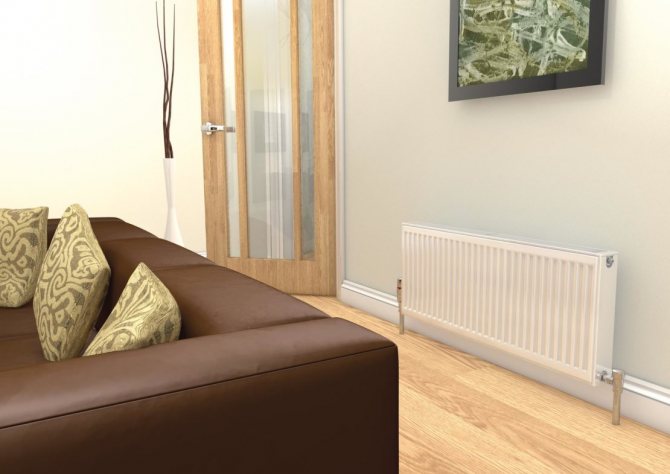

Panel units consist of one or more modules. Each panel consists of two roll-welded perimeter plates. In the process of stamping, channels are formed in the plates, placing them vertically. The coolant subsequently circulates through them.
To connect the modules, pipes are used from the same material from which the panels are made. To increase heat transfer, convectors are placed between the panels. Plate-type devices are installed behind one of the panels, and the gaps of the end planes are covered with a grill. Air circulates through the perforation of the grill, heats up on the heat exchanger and enters the room.
Due to the presence of convectors, the coolant needs less time to warm up a large room. Plus in fuel economy, minus - dust. Constant air circulation raises dust in the room, which negatively affects the health of people with allergies, diseases of the upper respiratory tract. This property must be taken into account when choosing convector panel radiators.
The installation of ozonizers, ionizers or devices for air purification will allow to level the disadvantage. The devices can be integrated into the ventilation network of the room or installed as independent units.
The scope has no restrictions, the devices work equally well in residential and non-residential premises.
Advice! If it is planned to install a panel radiator in a room with high humidity, it is recommended to buy devices with a moisture-resistant coating.
Varieties of panel-type radiators
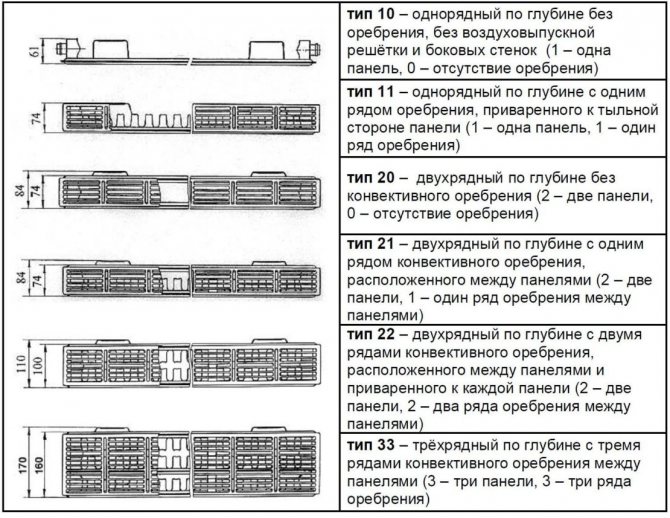

Devices are classified according to design features and sizes:
Batteries for a water heating system and how much radiators cost
- Single row. There are 10 types - these are devices without cladding and a convector, 11 type - with one convector, cladding. The width of the devices is 63 mm, the installation height is 300-900 mm, the length is 400-3000 mm.
- Double row. Produced in the following varieties: 12 - one convector, facing. 20 - there is a convector and an air passage grill. 21 - one convector, closed casing. 22 - 2 convectors, cladding. Height 300–900 mm. The length is different, sometimes 400-3000 mm or 400-2600 mm. The width of the double-row panel radiator 12 is 66 mm, all other devices have a width of 102 mm.
- Three-row. Models 30 are not equipped with cladding, convector, 33 have 3 convectors and cladding. Height of devices 300-900 mm, length 400-3000 mm, 400-2600 mm. Width 157 mm.
Important! Cost and heat dissipation depend on design features. Devices with convectors are more expensive, they warm up the room faster due to increased air circulation. Panels without convectors are cheaper, but heating takes longer.
Power of flat heating batteries
The larger the dimensions of the plane, the better the heat transfer and the higher the power indicator.
When choosing a thin radiator, you need to take into account a number of nuances:
- dimensions of the installation area;
- heated area of the room;
- building material;
- wall thickness;
- the size of windows, doors - heat escapes through them;
- the degree of thermal insulation of the building;
- the presence of a poorly insulated attic, basement;
- the height of the walls;
- the climate of the region.
Advice! The average power rating is indicated in the technical data sheet.

